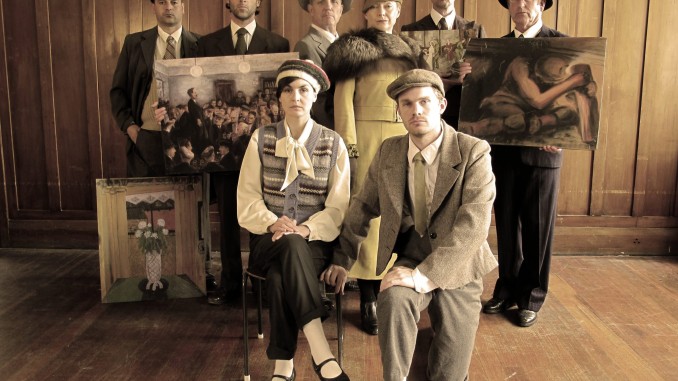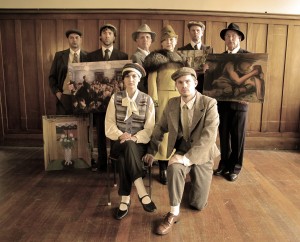
Billy Elliot meets RED [by James Wenley]

With Billy Elliot, everyone remembers the feel good inspirational story of the boy who became a ballet star. In revisiting the film recently, I was struck by the gritty social background – of Thatcher’s England and the miners sacrificing everything with lengthy strike action. For Billy, dancing was a way of escaping a life already set out for him; of following his father underground.
In his play The Pitmen Painters, Elliot screen-writer Lee Hall returns to similar concerns. Based on a book by William Feaver, and a fascinating real-life story, Hall follows the Ashington Group miners through the 30s/40s, who, encouraged by their art tutor, turn to painting for the first time and become darlings of the art world. While Elliott’s rags to riches dancing feet is a populist story (and later turned into a West End / Broadway musical with music by Elton John) and the Pitmen’s story is a far more intellectual one (this is Theatre with a capital ‘T’), they share much in common: Mining, social upheaval and class warfare – exchanging pickets for paints. One miner with great promise, Oliver, is offered a weekly stipend, worth more than his mining pay, to be a full-time painter – a chance to escape the mines and have a “proper creative life”. In both, we see Hall dealing with passions, creativity, self-expression in an otherwise oppressive environment.
Painters opened in Newcastle in 2007, transferred to the Royal National Theatre and even played a limited Broadway run with its original cast in 2010. This local production of The Pitmen Painters is elegantly directed by Paul Gittins for (potent pause) PRODUCTIONS.
The play opens with a group of Ashington men assembling for a class in Art Appreciation, held by the Worker’s Educational Association (WEA). Their first choice, an economics class (much more practical, they think), being unavailable due to lack of a suitable tutor. So, reluctantly, art it is then. Curiously, considering the title, only three of them – George (Geoffrey Snell), the by-the-the-book convener, Oliver (John Glass), the open one, and the slightly bristly Jimmy (Joseph Rye) – are actual miners. The other two are Harry Wilson (Stephen Papps), a Marx spouting Dental Assistant, and a Young Lad (Calum Gittins), unemployed, but not for lack of trying.
Enter Art Teacher Robert Lyon (Edward Newborn). They were expecting a professor. When his early efforts at Art History end only in confusion, he changes tack. He asks them to paint. None of them have ever done this before. The effect is revolutionary. The first assignment is to make what they know – “Work”. The resulting work, or at least from those who completed the assignment, is immediately stunning, leading to much discussion about representation, meaning, metaphors, the artist’s intention, criticism, and the value of art.
Auckland Theatre Company’s RED by John Logan, earlier in the year, canvassed similar themes, especially the ongoing concerns of what is art and who it is for. Both plays make these themes readily accessible – Rothko’s assistant and the Pitmen start in the same place as the audience as they begin their lessons with Mark Rothko and Robert Lyon. While RED is the showy piece, The Pitmen Painters is the more mannered affair. Much of the joy comes from the Pitmen’s discoveries and debates as they continue to create. The process becomes far more than just about the creation of art in itself, Oliver talks about this discovery in the terms of being his “own boss” for the first time in his life. Socialism, also gets much discussion.
The play tracks the Pitmen’s continued success from the first modest classes – interest from wealthy buyer Helen Sutherland (Elizabeth Hawthorne), their first exhibition, the thrill of seeing the great masters – to their decline – the coming of The Second World War and the art world moving on.
Director Gittins has bought together an impressive pallet of players. A scan of their bios reveals many have had both NZ and UK experience – accents aren’t a problem here. Oliver, the audience’s through-line and most developed character, is played with humility and truth by John Glass. Stephen Papps’ Marxist spiels bring a smile. Elizabeth Hawthorne brings her usual poise, and Calum Gittins, (who my colleague Sharu interviewed along with his Director Dad) is excellent as both the young lad and the spoilt artist Ben Nicholson. Josephine Stewart -Tewhiu’s role is all to brief. While on opening nights I usually tend to forgive the odd mistake, here there was an usually large number of fluffed and interrupted lines. While individually all actors were impressive, as a company they hadn’t quite seemed to gel.
John Verryt’s modest playing space of wooden floor, and hanging panels and three screens, feels at home in Q’s Loft space with its wooden beams. For the audience’s extra benefit, images of the miner’s paintings are shown on the screens, close-ups featuring relevant points of interest as the characters discuss them. Kristen Sorrenson’s costumes are authentic, with special support work from Milliner (hat maker) Karen Newborn. Nik Janiurek’s lighting frames the elements nicely.
Hall tells the story of the painters well, but as I watched the play I began to feel more and more bothered. I kept feeling a great sense of artificiality. It felt inauthentic. It seemed very clear what the playwright was doing. Each of the Pitmen had their role, and their argument positions on art. These points are made many times to make sure we have got them. At the end of Act One, the characters break the fourth wall to sum up their experience and thoughts about art, but this we already knew and had seen. While a few of the plot points would have still been left loose, this seemed to me to be a natural conclusion and the end of the play. Instead, interval was announced and Act Two went on to have many of the same arguments all over again.
The artificiality continued. A character’s death is foreshadowed by standing alone in spotlight (the script or the productions’ choice, I’m not sure), and most cynically at all, the audiences emotions are very precisely stirred by the old fallback of the character’s breaking into song – quietly at first, then in rousing fashion – at play’s end as they dream of a new era of socialism and equality (with our memory of Lee Hall’s other miners, we know this dream to be short lived).
It was as if I could see his technique – Lee Hall’s brush strokes made plain. This is not without a great sense of irony, as this sort of value judgment is very much a concern of the play. The tutor, Robert Lyon, while technically proficient, regrets not possessing the raw passion and creativity of his students. Lee Hall’s Pitmen Painters is like Lyon in this way – dramatically proficient, full of interesting ideas about art, impressive, nice to look at, but lacking a beating heart.
The Pitmen Painters is presented by (potent pause) PRODUCTIONS and plays at Q until 16 November to 10 December. Details see Q.
More information about the Ashington Group can be found here.




Leave a Reply